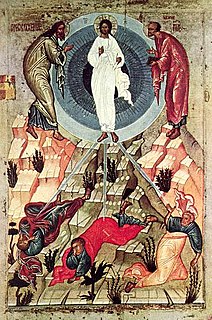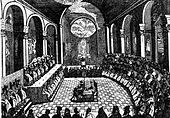
Bernard of Clairvaux, O. Cist., venerated as Saint Bernard, was an abbot, mystic, co-founder of the Knights Templars, and a major leader in the reformation of the Benedictine Order through the nascent Cistercian Order.

The First Council of the Lateran was the 9th ecumenical council recognized by the Catholic Church. It was convoked by Pope Callixtus II in December 1122, immediately after the Concordat of Worms. The council sought to bring an end to the practice of the conferring of ecclesiastical benefices by people who were laymen, free the election of bishops and abbots from secular influence, clarify the separation of spiritual and temporal affairs, re-establish the principle that spiritual authority resides solely in the Church and abolish the claim of the Holy Roman Emperor to influence papal elections.

The Fourth Council of the Lateran or Lateran IV was convoked by Pope Innocent III in April 1213 and opened at the Lateran Palace in Rome on 11 November 1215. Due to the great length of time between the Council's convocation and meeting, many bishops had the opportunity to attend what is considered by the Roman Catholic Church to have been the twelfth ecumenical council.
Pope Honorius II, born Lamberto Scannabecchi, was head of the Catholic Church and ruler of the Papal States from 21 December 1124 to his death in 1130.

Pope Innocent II, born Gregorio Papareschi, was head of the Catholic Church and ruler of the Papal States from 14 February 1130 to his death in 1143. His election as pope was controversial and the first eight years of his reign were marked by a struggle for recognition against the supporters of Anacletus II. He reached an understanding with King Lothair III of Germany who supported him against Anacletus and whom he crowned as Holy Roman emperor. Innocent went on to preside over the Second Lateran council.

The Third Council of the Lateran met in Rome in March 1179. Pope Alexander III presided and 302 bishops attended. The Catholic Church regards it as the eleventh ecumenical council.
Year 1139 (MCXXXIX) was a common year starting on Sunday of the Julian calendar.

Roger II was King of Sicily and Africa, son of Roger I of Sicily and successor to his brother Simon. He began his rule as Count of Sicily in 1105, became Duke of Apulia and Calabria in 1127, then King of Sicily in 1130 and King of Africa in 1148. By the time of his death at the age of 58, Roger had succeeded in uniting all the Norman conquests in Italy into one kingdom with a strong centralized government.
Anacletus II, born Pietro Pierleoni, was an antipope who ruled in opposition to Pope Innocent II from 1130 until his death in 1138. After the death of Pope Honorius II, the college of cardinals was divided over his successor. Unusually, the election was entrusted to eight cardinals, who elected Papareschi. A larger body of cardinals then elected Pierleoni, which led to a major schism in the Roman Catholic Church. Anacletus had the support of most Romans, including the Frangipani family, and Innocent was forced to flee to France. North of the Alps, Innocent gained the crucial support of the major religious orders, in particular Bernard of Clairvaux's Cistercians, the Abbot of Cluny Peter the Venerable; and Norbert of Xanten, the Archbishop of Magdeburg who established the Premonstratensians and held a high rank in the Court of the German Emperor Lothar III.
Victor IV was an antipope for a short time, from March to 29 May 1138.
The Lateran councils were ecclesiastical councils or synods of the Catholic Church held at Rome in the Lateran Palace next to the Lateran Basilica. Ranking as a papal cathedral, this became a much-favored place of assembly for ecclesiastical councils both in antiquity and more especially during the Middle Ages.

Robert II was the count of Aversa and the prince of Capua from 1127 until his death.

According to the Catholic Church, a Church Council is ecumenical ("world-wide"), if it is "a solemn congregation of the Catholic bishops of the world at the invitation of the Pope to decide on matters of the Church with him".
Oderisio di Sangro was an Italian Benedictine monk and cardinal, the son of Count Rinaldo of the family of the conti di Sangro in the Marsi.
Gilo of Toucy, also called Gilo of Paris or Gilo of Tusculum, was a French poet and cleric. A priest before he became a monk at Cluny, he was appointed cardinal-bishop of Tusculum sometime between 1121 and 1123. He served as a papal legate on four occasions: to Poland and Hungary around 1124, to Carinthia in 1126, to the Crusader states in 1128 or 1129 and to Aquitaine from 1131 until 1137. He took the side of the Antipope Anacletus II in the papal schism of 1130 and was deposed as cardinal-bishop by the Second Lateran Council in 1139.
The 1143 papal election followed the death of Pope Innocent II and resulted in the election of Pope Celestine II.
An incomplete list of events in 1139 in Italy:
The following outline is provided as an overview of and topical guide to the Catholic Ecumenical Councils.
The Council of Pisa, was convened by Pope Innocent II in May 1135. An extraordinary number of prelates, archbishops, bishops, monks, and abbots attended the council, including a large number of Italian clergy. The council addressed simony, schismatic clerics, heresy, as well as donations to the Templar Order. Pisa would be the third council Innocent would convene to address issues within the Catholic Church.





